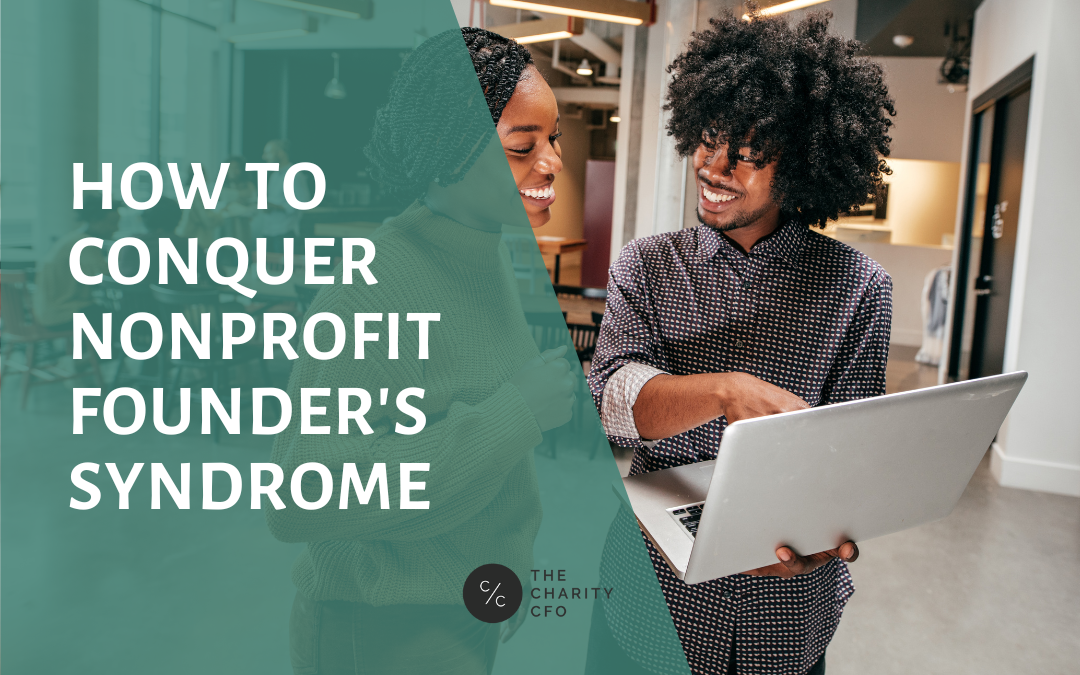Nonprofit founders are creators, visionaries, and leaders.
They invest time, talent, and charisma to build a mission-focused organization from scratch. And they corral the first donations and design and implement programming from scratch.
So it’s natural that their hand-picked board of directors and the first few staff members come to rely on the vision of the founder. After all, without the founder’s vision, the organization wouldn’t exist.
But when the founder’s personality or personal story gets confused with the organization’s mission, the organization can face a cascade of issues. This phenomenon is called founder’s syndrome. And it can be damaging, or even fatal, to an organization’s long-term goals.
So let’s take a look at what it is, how to avoid it, and how to overcome it to build an organization that is bigger than any single person.
What is nonprofit founder’s syndrome?
Founder’s syndrome is an issue where a nonprofit’s founding member(s), and often their board members and employees, view the organization as inseparable from the founders themselves.
From the founder’s perspective, it sounds like this:
“I am this nonprofit. It needs me to survive. If I step away, everything I’ve built will collapse.”
When this happens, others in the organization tend to mirror the founder’s perspective, which sounds like this:
“The founder is the nonprofit. We need their guidance. We can’t survive without their leadership.”
It is ironic that founder’s syndrome is so widespread in the nonprofit world because nonprofit organizations, by their very structure, belong to the community, donors, and the public and NOT to an individual.
Yet, because nonprofits are often born of the founder’s passions and built from nothing with their effort and determination, it’s easy for a founder to start to believe that they’re the only person capable of executing their vision.
Why is founder’s syndrome so dangerous for nonprofits?
Founder’s syndrome keeps nonprofits from growing their mission in a sustainable and scalable way. The founder feels the need to be involved in every decision, so they become a roadblock to progress and limit the development of their team members.
When your employees (even management-level employees) feel that the direction comes from the top down, they’re less likely to take action on their own. And they’ll be less creative in developing solutions or strategies that spark change.
And boards of directors that rubber-stamp a founder’s decisions are mainly abandoning their responsibility to provide financial oversight. Why have all these “experts” advise your organization if you don’t utilize their perspective and experience?
But in the long term, founder’s syndrome seriously threatens your organization’s ability to survive when the founding member leaves the organization.
Suddenly, nobody knows who to listen to. People aren’t accustomed to taking charge, and they question the new leadership’s decisions. And the systems and structures are often set up to support the founder’s needs rather than the organization’s needs.
The consequences of long-term founder’s syndrome can even be fatal.
But if nonprofit founder’s syndrome has started to grow in your organization, now is the time to take explicit steps to combat it and ensure you can survive and thrive without being dependent on any one person.
How can a nonprofit avoid founder’s syndrome?
The first step in conquering founder’s syndrome is for the founder to recognize the problem. And to consciously put their ego aside and acknowledge that their mission is bigger and more important than themself.
Whether you’re just starting your organization or founder’s syndrome has already begun to creep into your company culture, here are some steps you can take to void it:
Choose your words carefully.
When talking about your organization, the words you choose influence how people perceive the founder’s role in the organization.
Don’t use singular pronouns or people individual’s names, like my nonprofit or Tosha’s organization, when describing the organization. And gently correct people if they use these phrases. Instead, use inclusive terms such as the organization, the mission, and our team.
Similarly, how constituents refer to the leaders makes a difference. For example, “The founder” indicates a full stop: the organization begins and ends with that one person. Instead, consider a title like “Founding CEO,” which indicates sustainability and longevity.
Their founding role is essential, but it also indicates that the CEO’s role is a job that will last beyond the founder’s tenure at the nonprofit.
Establish job descriptions
Everyone, including the founding CEO and members of the founding boards of directors, needs to know what their role is within the organization. Without well-defined expectations, individual team members can’t take ownership of their area of the business.
Delegate & trust your team
And once you’ve created job descriptions, let each team member handle their role independently to the extent possible. Try to delegate responsibility and manage outcomes, rather than holding their hand through every minor decision. Of course, managing people will take more time and effort at the start. But in the end, it makes your job easier and ensures the organization doesn’t depend on any one individual.
Use the mission as a litmus test.
Before making any management decision, ask yourself this question:
Is this the right decision for the good of the mission, or is it about my ego?
While other people can sometimes identify nonprofit founder’s syndrome from the outside, it’s hard to ensure the longevity of the nonprofit if the founding member cannot honestly evaluate their motivation for making decisions.
What are the signs of founder’s syndrome?
It can be hard to self-diagnose founder’s syndrome, but founding members and team members should be on the lookout for these signs:
The stress is overwhelming.
If the founder is still performing all the tasks of running the nonprofit, even after it is established and stable, they are likely over-identifying with the organization.
Is there enough money to hire staff? If so, why hasn’t the money been used to hire qualified staff? And if not, is the organization viable?
Part of growing an organization is delegating. A founder can practice this skill by appointing qualified staff to support and run different aspects of the nonprofit. Build confidence in the organization as an entity apart from the founder.
Donors, board members, or employees can’t “imagine” the nonprofit without the founder.
Founders play a vital role in getting a nonprofit up and running. Their personality is crucial to establishing the mission, finding the first significant contributors, and engaging the community in the vision.
But when staff or board members say things like, “I don’t know what would happen if they left,” their personality may threaten your mission’s sustainability.
How to recover from nonprofit founder’s syndrome
Darcella Craven understands the challenges of recovering from founder’s syndrome first-hand after successfully replacing a founding CEO.
She joined our CEO Tosha Anderson on A Modern Nonprofit Podcast to share her insights on avoiding, identifying, and recovering from founder’s syndrome.
Darcella suggests a three-pronged approach to new leaders charged with replacing a founder:
1. Assess the situation.
As the second CEO of an organization, it’s crucial to begin by getting your bearings. Conduct a thorough assessment. Ask questions. Investigate. And listen very carefully to all constituents.
- How are the staff and board performing? How do they feel about the transition?
- What challenges are facing the organization? What opportunities are available?
- How healthy is the financial position?
- Is the nonprofit’s position in the market stable? Is the mission necessary, or was this a pet project of the founding member?
While some of these assessing questions will lead to difficult conversations, engage in them anyway. Being a successor requires courageous leadership.
2. Communicate with the board
Successors must often work with a founding board. In other words, the board members likely consist of the founder’s family, friends, or long-time colleagues. Some of them are probably those who contributed financial resources to help start the organization.
One-on-one conversations with each board member will help a successor understand the lay of the land and develop their leadership strategy.
- How does each member feel about the transition? How do those feelings affect their mindset?
- How did the board as a whole relate to the founder? Did they provide oversight or a rubber stamp?
- Does each member contribute to the skillset of the board?
- Do they understand their responsibilities within the board structure, and are they qualified to oversee the organization?
3. Set clear goals
Once a successor understands the history and current state of the organization, they can turn to the work of writing the next chapter. Lead the nonprofit forward with clearly defined goals and objectives, and then identify strategies to drive the organization toward those goals.
- What goals will move the organization toward its mission?
- What procedures and mindsets are still serving the organization? What needs to change so that the organization can grow?
- Could strategic partnerships, collaborations, or relationships help the nonprofit into this new era?
Founder’s syndrome and your nonprofit finances
Some of the most dangerous outcomes of founder’s syndrome come when team members are afraid to be honest with a founder about the organization’s finances.
Nonprofit financial management must be a team effort, with the directors, board members, and team members having transparency and accountability for finances.
But your team can’t be accountable for their financial impact if they don’t have updated and accurate financial data. If you need a reliable partner to get timely financial data and keep your books always audit-ready, reach out to The Charity CFO for a free consultation.
Our team of former nonprofit CFOs and auditors have seen founder’s syndrome’s financial impact on nonprofits. We’ll help you create an accounting system that gets you the information you need to ensure your mission is sustainable.
Get My Free Consultation
Do You Struggle to Make Sense of Your Financial Statements?
Get our FREE GUIDE to nonprofit financial reports, featuring illustrations, annotations, and insights to help you better understand your organization's finances.
Get the free guide!




0 Comments